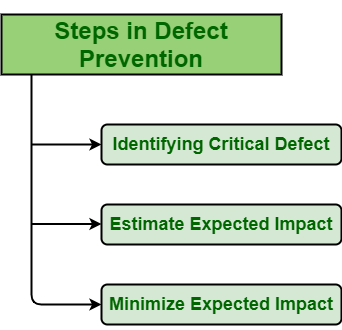Different steps involved in Defect Prevention
Last Updated :
08 Sep, 2020
Defect Prevention (DP) is usually considered as a process of simply preventing defects from their re-occurrence in Software Development Life Cycle (SDLC). Here, defects are basically defined as errors that might occur in different stages of SDLC. It is one of best methods to remove defects at an early stage of testing rather than identifying it at later stage and then resolving it.
Steps involved in DP :
There are basically three steps of defect prevention process as given below :

- Identifying Critical Defect :
Identification of defect is one of major part of defect prevention. During SDLC, different types of defects are encountered. Each defect has different impact on system. Some of them have severe impact i.e. largely affects system, some of them are less severe i.e. have less impact on system, and some of them have very less impact on system that can be considered as negligible. Therefore, it is very important to identify critical and more severe defects in system at soon as possible. Critical defects are very severe and have more impact on system as on their occurrence, they might stop the functioning of overall system or can cause some other problems on greater level. So, it is very much essential to identify critical defects.
- Estimate Expected Impact :
Estimating expected impact of defect on cost is also important part of defect prevention. Whenever defect is encountered in system, main questions arises is what are measures that are needed to be taken to resolve it and amount required to resolve it. More critical defect is, more will be amount required to resolve it as more effort and resources will be required to resolve it. Therefore, it’s better to estimate expected impact of defect on cost if defect somehow encounters or occurs. After that, some measures should be taken to minimize their occurrence.
- Minimize Expected Impact :
After identifying and estimating impact of critical defects, one should take some measures actions to minimize or eliminate defects permanently before its occurrence. Minimizing expected impact is also important part of defect prevention. If one could not eliminate defect, then he/she should try to reduce possibility of its occurrence and its impact.
Advantages of DP :
- Number of defects in a system is reduced or minimized by taking some measures required.
- Checklist that is being developed for review is improved.
- Amount of work required to fix defect is reduced as number of defects is minimized.
- Overall cost of production is reduced as cost required to resolve defect is minimized by taking some measures to prevent defect from re-occurrence.
- Helps in making software defect-free as much as possible.
- Increase overall quality of software products.
- Improves software process by backing up testing process and minimizing cost required of resolving errors.
Share your thoughts in the comments
Please Login to comment...